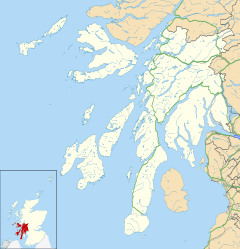Glen Nant facts for kids
Quick facts for kids Glen Nant National Nature Reserve |
|
|---|---|
|
IUCN Category IV (Habitat/Species Management Area)
|
|

View over Glen Nant Looking towards Ben Cruachan
|
|
| Location | Argyll and Bute, Scotland |
| Area | 338.5 ha (836 acres) |
| Designation | NatureScot |
| Established | 1979 |
| Owner | Forestry and Land Scotland (FLS) |
| Glen Nant National Nature Reserve | |
Glen Nant (Scottish Gaelic: Gleann Neannta) is a beautiful valley in Scotland. It's located south of Taynuilt in the Argyll and Bute area. A large woodland area here, covering about 339 hectares, is a special place called a National Nature Reserve (NNR). It is looked after by Forestry and Land Scotland (FLS).
This woodland is a great example of an "Atlantic Oakwood." This type of forest grows in places with lots of rain, like the west coast of Scotland. Glen Nant is one of the biggest oak woodlands in northern Argyll.
Contents
A Rich History: From Industry to Nature Reserve
For many years, the trees at Glen Nant were used by people. In the 1700s and 1800s, the woodland was "coppiced." This means trees were cut down to ground level, and then new shoots would grow from the stump. This was done to get lots of bark for the tanning industry, which made leather.
Charcoal for Iron Smelting
The wood was also turned into charcoal. This charcoal was sent to the iron furnace at Bonawe, where it was used to make iron. Oak trees were the best for both tanning and charcoal, so they became the main type of tree in the area. Other trees mostly grew in places that were hard to reach.
Becoming a Protected Area
Later, in the 1970s, the Forestry Commission (which is now FLS) started planting different types of trees, like Sitka spruce. These trees were grown for commercial use. However, people soon realized how special the oak woodland was.
In 1979, after talks between the Nature Conservancy Council (now NatureScot) and the Forestry Commission, Glen Nant was officially made a National Nature Reserve. Fences were put up to help new trees grow naturally. Since then, people have worked to remove trees that don't belong there and bring back the old coppicing methods in some parts. In 2003, the NNR was made even bigger.
Amazing Plants and Animals
Glen Nant is home to many different kinds of woodlands. This means it has a huge variety of plants and animals.
Diverse Trees and Plants
You can find ash and hazel trees growing in areas with rich soil. On more acidic soils, you'll see oak and birch trees. Other trees include wych elm, gean, holly, alder, and sallows.
Because of these different tree types, many other plants thrive here. You'll find ferns and heath plants on acidic soils, and various herbs in the lime-rich areas. Over 234 types of lichen have been found here! Most of these lichens need damp, oceanic conditions to grow.
Insects and Mammals
If you visit, you might spot Wood ants, which are very common. But the woods also have rarer insects, like the cranefly Tipula luridorostris. Scientists believe there are about 175 different kinds of butterflies and moths here. There are also two types of flies that are very rare in the UK.
As for mammals, you might be lucky enough to see red squirrels playing in the trees or otters near the water.
Visiting Glen Nant
Glen Nant is a great place to explore! There are two easy walking trails for visitors.
Walking Trails
- The Riverbank Trail is about 400 meters long. It starts at the car park and leads to a picnic area right by the River Nant.
- The Ant Trail is a longer, circular route, about 3.3 kilometers. It takes you through the beautiful oakwoods. The charity Plantlife has a leaflet that points out some of the amazing plants you can see on a 1.6 km part of the Ant Trail.
Cycling Access
The National Cycle Route 78, also known as the Caledonia Way, passes right by the entrance to the reserve. It follows a section of the B845.
Why Glen Nant is Protected
Glen Nant is very important, which is why it has several special protections.
It is a National Nature Reserve (NNR). It is also a Site of Special Scientific Interest (SSSI), which means it's important for its plants, animals, or geology. Plus, it's part of the Loch Etive Woods Special Area of Conservation (SAC), a European designation for important habitats.
The International Union for Conservation of Nature (IUCN) has given Glen Nant a Category IV protected area status. This means it's managed mainly for conservation through active management.


